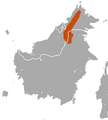Aethalops
| Aethalops | ||||||||||||
|---|---|---|---|---|---|---|---|---|---|---|---|---|
| Systematics | ||||||||||||
|
||||||||||||
| Scientific name | ||||||||||||
| Aethalops | ||||||||||||
| Thomas , 1923 |
Aethalops is a genus in the family of bats with two species in Southeast Asia occur.
features
With a head-torso length of 65 to 73 mm and a forearm length of 42 to 52 mm (up to 46 mm in A. aequalis ), the species are among the smallest flying foxes, a tail is missing. A specimen of A. alecto weighed 19.3 g. The color of the thick fur on the top varies between gray, black and red-brown (in A. aequalis ). The fur is generally lighter on the underside. Both species have a narrow, fur-covered tail fly skin ( uropatagium ) and a short heel spur ( calcar ). In contrast to Balionycteris maculata , there are no bright points on the flight skin . The Aethalops species have only two lower incisors and one less outer molar in each upper half of the jaw than Balionycteris maculata .
distribution and habitat
The distribution area of Aethalops alecto extends from the south of the Malay Peninsula via Borneo , Sumatra , Java and Bali to Lombok . Aethalops aequalis occurs only in the north of Borneo. The species live in forest-covered mountains between 600 and 2,700 meters above sea level. However, sightings above 1,800 meters above sea level are rare.
Way of life
These flying foxes are nocturnal. They rest upside down in the branches of the trees, where they hold on with their feet. There they sleep alone or in small groups with two or three individuals. The food consists among other things of fruit juice, whereby the solid components are spit out again. The species also eat nectar and pollen . They can flutter like hummingbirds in front of the flower without changing their position significantly.
The reproduction probably corresponds to other fruit bats with one litter per year that consists of only one young.
Systematics
The taxon Aethalops aequalis was listed as a subspecies of Aethalops alecto until the 1990s . Various morphological deviations led to recognition as a species. Thus, in Aethalops aequalis, all incisors are of the same length, while the inner upper incisors in Aethalops alecto are smaller than the outer ones.
status
Tree felling as a forestry measure or slash and burn to gain arable land can threaten the stands in the long term. In general, both species are still quite common, so that they are listed as Least Concern by the World Conservation Union (IUCN) .
Individual evidence
- ↑ a b c d e f g S. Freier: Borneo fruit bat in the Animal Diversity Web of the University of Michigan Museum of Zoology. Retrieved November 8, 2015.
- ↑ a b c d Ronald M. Nowak: Aethalops Walker's Mammals of the World. Volume 1. p. 291, 6th edition. Johns Hopkins University Press, Baltimore MD et al. 1999, ISBN 0-8018-5789-9 .
- ↑ a b Aethalops in the IUCN Red List of Threatened Species 2008. Accessed November 8, 2015.
- ↑ Don E. Wilson, DeeAnn M. Reeder (Ed.): Mammal Species of the World . A Taxonomic and Geographic Reference . 3. Edition. tape 1 . Johns Hopkins University Press, Baltimore 2005, ISBN 0-8018-8221-4 , pp. 314 f . (English, Aethalops [accessed June 15, 2016]).

